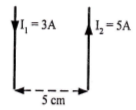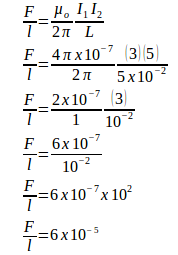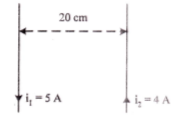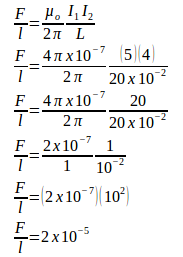Magnetic force between two parallel wires – problems and solutions
1. Two parallel conductors carrying currents I1 and I2, as shown in the figure below. What is the magnitude and direction of the magnetic force experienced by both conductors? (μo = 4π. 10-7 Wb.A-1.m-1)
Known :
The electric current 1 (I1) = 3 Ampere
The electric current 2 (I2) = 5 Ampere
The permeability of free space (µo) = 4π x 10-7 wb A-1 m-1
Distance between both conductors (L) = 5 cm = 5 x 10-2 meters
Wanted: The magnitude and direction of the magnetic force
Solution :
The direction of the electric current on conductor 1 is opposite with the direction of the electric current on conductor 2. Antiparallel currents (in opposite directions) exert a repulsive force on each other.
The magnitude of the magnetic force :

F/l = 6 x 10-5 Newton
2. Two parallel wires carrying currents I1 and I2 are 20-cm apart. What is the magnitude of the magnetic force experienced by each wire (μo = 4π. 10-7 Wb.A-1.m-1)
Known :
The electric current 1 (I1) = 5 Ampere
The electric current 2 (I2) = 4 Ampere
The permeability of free space (µo) = 4π x 10-7 wb A-1 m-1
Distance between both wires (L) = 20 cm = 20 x 10-2 meters
Wanted: The magnitude of the magnetic force
Solution :
The direction of the electric current on conductor 1 is opposite with the direction of the electric current on conductor 2. Antiparallel currents (in opposite directions) exert a repulsive force on each other.
The magnitude of the magnetic force :

F/l = 2 x 10-5 Newton
20 conceptual questions and answers related to the magnetic force between two parallel wires:
1. Question: What is the primary cause of the magnetic force between two parallel current-carrying wires?
Answer: The magnetic force between two parallel wires arises due to the magnetic fields produced by the currents in each wire acting on the other wire.
2. Question: How does the direction of current in the two wires affect the force between them?
Answer: If the currents flow in the same direction, the wires attract each other. If the currents flow in opposite directions, the wires repel each other.
3. Question: What is the relationship between the distance between the wires and the magnetic force?
Answer: The magnetic force is inversely proportional to the distance between the wires. As the distance increases, the force decreases.
4. Question: How does the magnitude of the current in the wires affect the force?
Answer: The force is directly proportional to the product of the currents in the two wires.
5. Question: What happens to the force if one of the wires has no current?
Answer: The force will be zero because a wire with no current doesn’t produce a magnetic field to affect the other wire.
6. Question: Why is the magnetic force between two parallel wires considered a non-contact force?
Answer: The force is due to the interaction of their magnetic fields, not direct physical contact.
7. Question: How does the magnetic field produced by one wire vary with distance?
Answer: The magnetic field strength decreases with increasing distance from the wire.
8. Question: Can the magnetic force between two parallel wires be shielded or blocked?
Answer: While it’s challenging to completely shield magnetic fields, using materials with high magnetic permeability can redirect and reduce the effect of the fields on each other.
9. Question: If the two wires are perpendicular to each other, how does the magnetic force between them change?
Answer: If the wires are perpendicular and their currents cross paths, they won’t exert a simple attractive or repulsive force on each other as parallel wires do.
10. Question: How is the direction of the magnetic force on a current-carrying wire determined?
Answer: The direction can be determined using the right-hand rule: point the thumb in the direction of the current, and the curled fingers will indicate the direction of the magnetic field.
11. Question: Is the magnetic force between two parallel wires a central force?
Answer: No, it’s not a central force because the direction and magnitude of the force depend on both the relative orientation and separation of the wires.
12. Question: Can the wires feel a force even if they are placed in a vacuum?
Answer: Yes, the magnetic force between the wires doesn’t rely on a medium; it can exist in a vacuum.
13. Question: How is the unit of current, the Ampere, related to the force between two wires?
Answer: One Ampere is defined as the current that, when flowing in two parallel conductors of infinite length and placed one meter apart in a vacuum, results in a force of 2 x 10^(-7) Newtons per meter of length between the wires.
14. Question: Do the materials of the wires affect the magnetic force between them?
Answer: The material of the wires does not directly affect the force. The force depends on the current and the distance between the wires.
15. Question: What is the role of the permeability of free space (μ₀) in the force between two parallel wires?
Answer: The permeability of free space is a constant that relates magnetic field strength to the current causing it and appears in the formula for the force between two current-carrying wires.
16. Question: Can magnetic forces do work on the wires?
Answer: While magnetic forces can exert a force on a current-carrying wire, they don’t do work as they act perpendicular to the direction of motion.
17. Question: How do the lengths of the wires affect the magnetic force between them?
Answer: The force is proportional to the lengths of the wires that are parallel and close to each other.
18. Question: Are there any real-life applications or consequences of the magnetic force between parallel wires?
Answer: Yes, in electrical circuits, especially those with high currents, the magnetic interaction between wires can cause them to move, which needs to be considered in design.
19. Question: If one wire is coiled into a loop, how does it affect the magnetic force?
Answer: A coiled wire, or solenoid, produces a stronger magnetic field than a straight wire, altering the force between it and another wire.
20. Question: Can the magnetic forces between parallel wires be used to measure current?
Answer: Yes, devices like current balance utilize the magnetic force between wires to measure current by equating it to a known mechanical force.
Understanding the magnetic force between parallel wires is fundamental in electromagnetism and has implications in circuit design, electronics, and electrical engineering.
